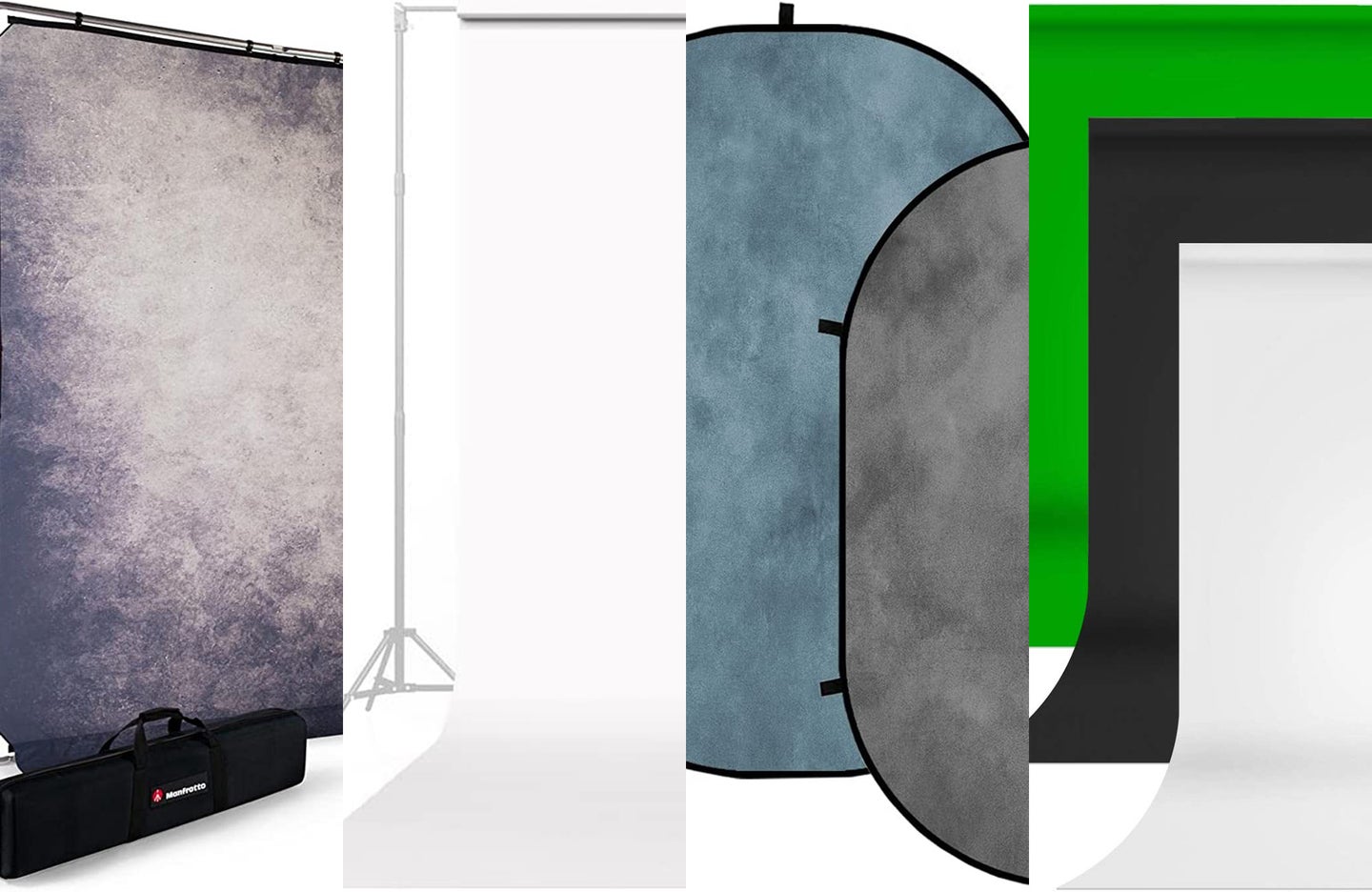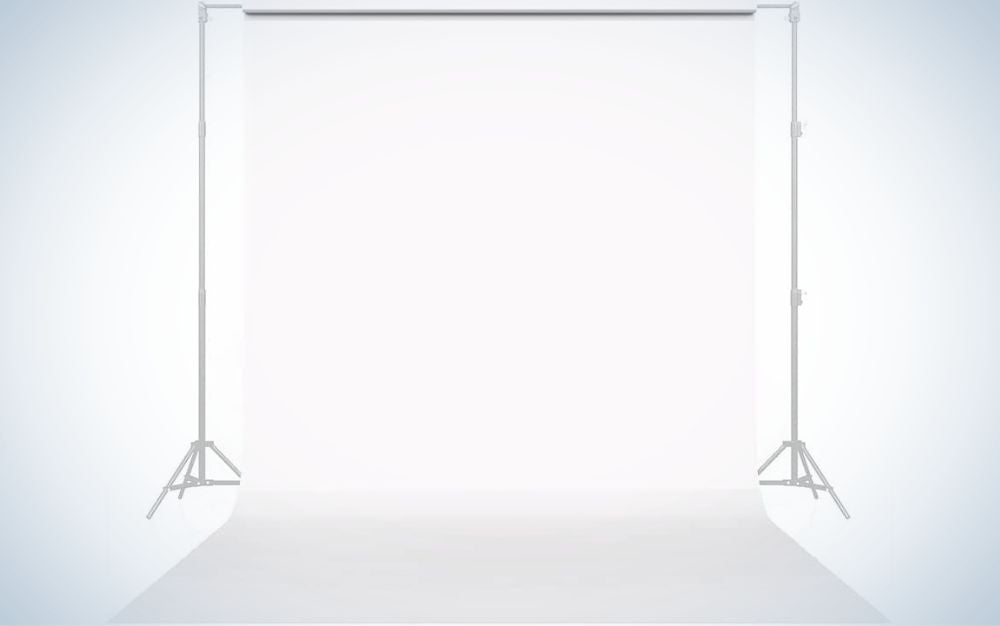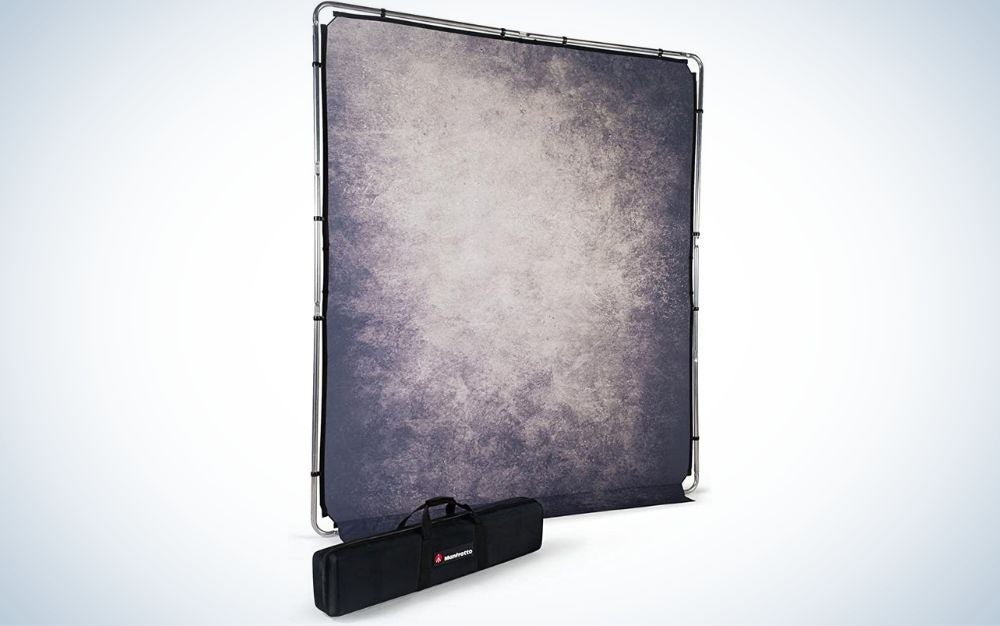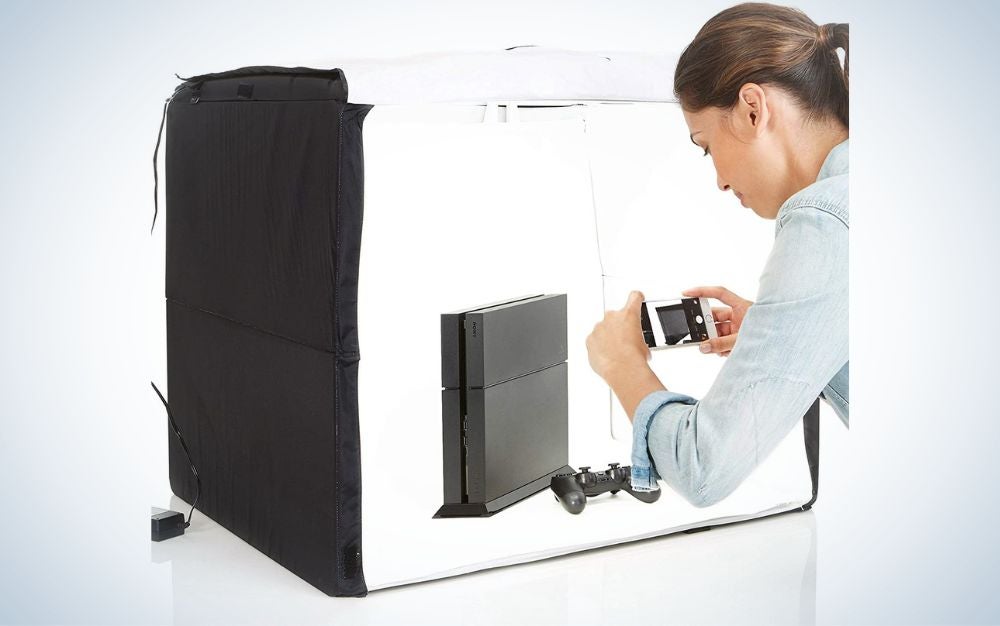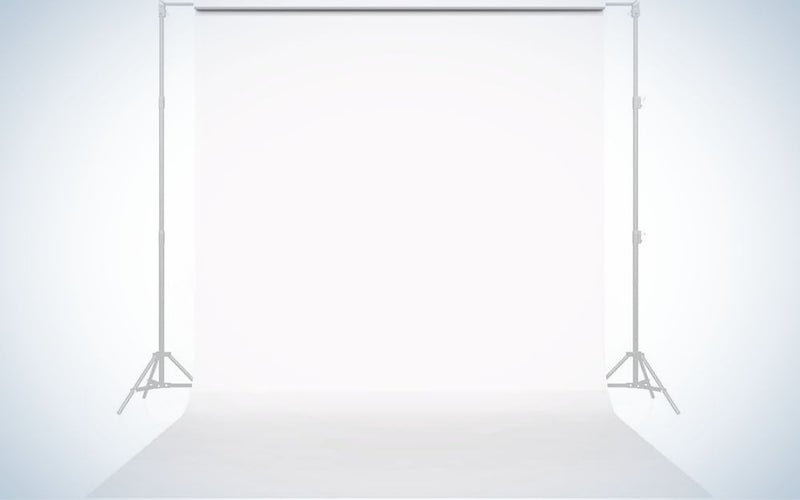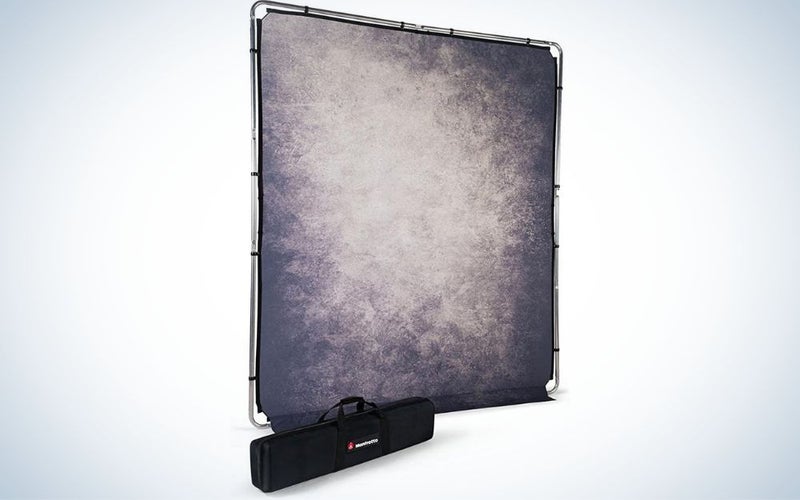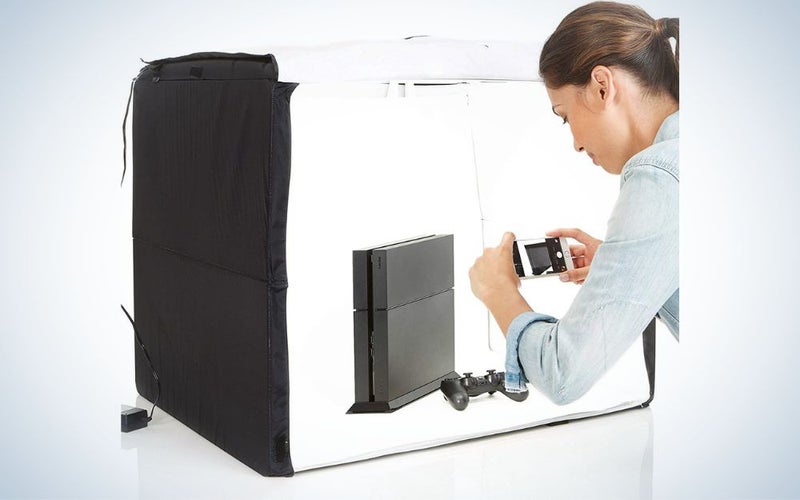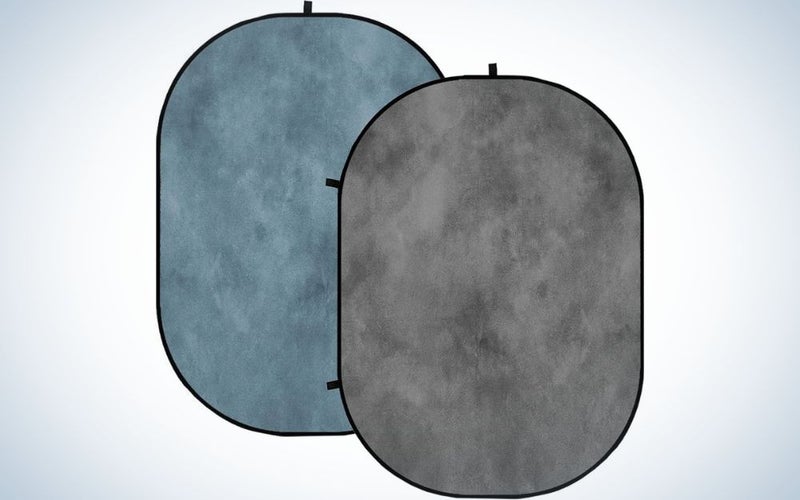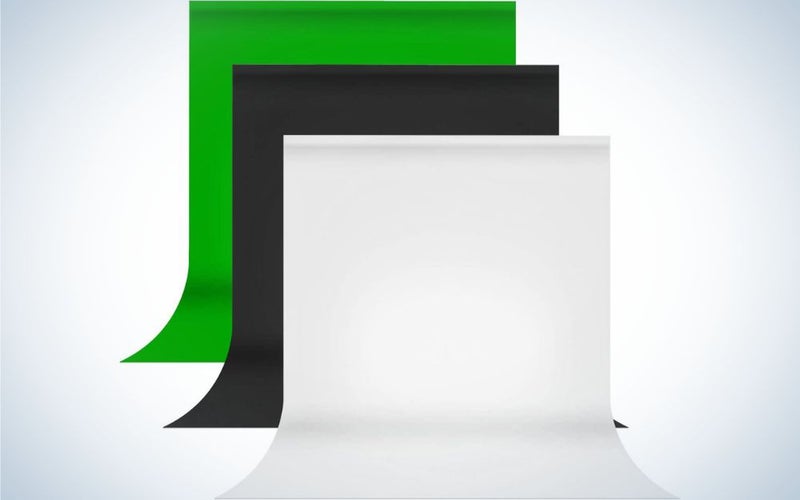We may earn revenue from the products available on this page and participate in affiliate programs. Learn more ›
Adding a photography backdrop (or a few) to your kit is a great way to elevate the professional quality of your work easily. They are indispensable tools if you are working in the studio as a portrait or product photographer, but they can also be extremely helpful for videographers and other content creators. And they can add a unique element to outdoor shoots. Keep reading to learn more about some of the best photography backdrops currently available.
- Best overall: Savage Seamless Backdrop Paper
- Best high-end portable: Manfrotto EzyFrame Vintage Background Kit, 6.5×7.5′, Concrete
- Best for product photography: Amazon Basics Portable Foldable Photo Studio Box
- Best foldable: Kate Collapsible Backdrop Pop-up
- Best budget: Julius Studio 9 x 13 Ft. Photo Studio Chromakey Background Muslin Backdrop Bundle Kit
How we chose the best photography backdrops
When selecting the backdrops in this buying guide, it was important to consider a wide variety of budgets for different styles of photographers. For example, someone who primarily works shooting small products or on-figure e-commerce will have very different backdrop needs than a photographer focused on headshots or editorial portraiture.
In making our selections for this buying guide, we considered products we have personally used on shoots, referenced editorial reviews, and user feedback.
The best photography backdrops: Reviews & recommendations
Whether you are a videographer looking for a background for your vlogs or a portrait photographer hoping to take your studio to the next level, these photography backdrops will get the job done.
Best overall: Savage Seamless Backdrop Paper
Savage
Specs
- Color: White (available in 55 colors)
- Material: 163 GSM paper
- Dimensions: 107 inches wide, 36 feet long (available in 9 sizes)
- Weight: Not provided
Pros
- Affordable
- Industry-standard for creating a smooth look
- Available in 55 colors
- Available in a variety of sizes
Cons
- Need tall ceilings to store
- Difficult to set up larger rolls while working solo
Savage Seamless Paper is an indispensable tool for photographers and videographers of all levels and a staple of the photo studio. This industry standard product is made of thick, non-reflective paper making it great for a wide variety of shoots. It’s available in 55 vibrant colors and is 100 percent recyclable. And it comes in a range of sizes, making it one of the best photography backdrops for all sorts of photographers and photography subjects. Plus, once you are done with your shoot, you simply trim off the bottom section of the paper and re-roll. So there’s no need to fuss over ironing or steaming out wrinkles and creases before your next shoot.
Best high-end portable: Manfrotto EzyFrame Vintage Background Kit, 6.5×7.5′, Concrete
Manfrotto
Specs
- Color: Concrete
- Material: Fabric
- Dimensions: 6.5 x 7.5 feet
- Weight: 10.7 pounds
Pros
- Good for travel
- Easy to set up
- Good for portraits or small groups
- Comes with a carrying case
Cons
- Expensive
- Limited colors
This combo kit and frame make it easy to set up a beautiful, professional-looking backdrop wherever your shoot may take you. Although it’s pricey, the frame is easy to set up solo and has a durable build. Plus, the muslin backdrop clips on, cutting down on the time it will take you to get the whole thing set up for your shoot.
The backdrop itself comes in ten colors, including Olive, Tobacco, Concrete, and Smoke. But we don’t see a reason why you wouldn’t be able to attach any fabric you want to the frame with a few handy clamps to increase the versatility of this kit.
Best for product photography: Amazon Basics Portable Foldable Photo Studio Box
Amazon Basics
Specs
- Color: White
- Material: Fabric
- Dimensions: 30 x 25 x 25 inches
- Weight: 14 pounds
Pros
- Good for product photography
- Small setup for compact spaces
- Front 3-door design minimizes reflections
- Comes with built-in LED lights
Cons
- Limited functionality for larger items
This tabletop lightbox is an ideal backdrop for shooting product photography or small still lifes. It measures 25 by 30 by 25 inches when popped open but collapses into a thin portfolio case when not in use. It includes a power supply, a pre-installed white backdrop, and built-in 5600K daylight-balanced LED lights. The setup makes it easy to professionally shoot your products even with only a smartphone.
The front three-door system will maximize the number of angles you can shoot from while also reducing outside reflections. In addition, this particular model happens to be compatible with the Amazon Seller app—making it easy to shoot, edit, and upload images directly to Amazon.
Best foldable: Kate Collapsible Backdrop Pop-up
Kate
Specs
- Color: Teal and grey
- Material: Microfiber
- Dimensions: 78 x 60 inches
- Weight: 5.59 pounds
Pros
- Easy to set up and travel with
- Good for headshots or use as a zoom background
- Safe to iron
Cons
- Tends to get wrinkly
This double-sided pop-up backdrop functions similarly to a 5-in-1 photo reflector. It’s made of microfiber material and is safe to iron in case of wrinkles. Each backdrop comes with two colorways for diverse looks, and when it is unfolded measures 5×6.5 feet—making it an excellent option for shooting headshots of adults or portraits of children.
Three hook and loop fasteners make it easy to attach to a backdrop or light stand while shooting. It’s a lower-cost, portable option that looks great if you are only shooting one person at a time.
Best budget: Julius Studio 9 x 13 Ft. Photo Studio Chromakey Background Muslin Backdrop Bundle Kit
JS JULIUS STUDIO
Specs
- Color: Black, white, and green chromakey
- Material: Polyester muslin
- Dimensions: 9 x 13 feet
- Weight: 9.24 pounds
Pros
- Lightweight, easy to travel with
- Machine washable
- Rod pocket makes it easy to hang
Cons
- Prone to wrinkling
- Rod pocket sizes vary
This budget backdrop bundle includes three cloth backdrops in some of the most popular colors: black, white, and chroma key (which you can use for shooting greenscreen). They have a machine washable design and a rod pocket for hanging on a crossbar stand. And because they are made of cloth, they are extremely easy to travel with.
Although this option is certainly budget-friendly, this style of cloth backdrop is prone to wrinkling, so it’s helpful to have a steamer or iron on hand to smooth things out before your shoot. Also, based on some user reviews, the rod pocket sizes vary, resulting in incompatibility with some backdrop stands. But if you are looking to save, you certainly can’t beat the price.
Things to consider before buying the best photography backdrops
Backdrop material
The most important thing to consider before buying a backdrop for your photography or videography project is to consider what the needs of the project are. Our overall choice for a photography backdrop is the versatile seamless paper because it works so well for so many different scenarios and so many different kinds of photographers. Although larger rolls of seamless can be more difficult to travel with, in many ways, they remain the best tool for working in the studio or on location somewhere.
High-quality fabric backdrops tend to be more expensive, but they will last you a lifetime. If you are a portrait photographer honing a specific style or working on a project that requires a level of consistency from image to image, going with a more expensive fabric backdrop might be a more ideal option.
Size
The final thing to consider is backdrop size. If you are shooting large groups of people, you will need a much bigger backdrop than if you are shooting headshots, children’s portraits, still lifes, or product photography.
Ultimately the best backdrop for you depends a lot on where you are shooting, what you are shooting, and your personal preferences as a photographer. It’s not unusual for professionals to have a few different backdrop options at the ready, depending on the shoot.
FAQs
Q: Where do photographers get their backdrops?
Photographers get their backdrops from a wide variety of places depending on what their needs for a particular shoot might be. It’s not unusual for photographers to have a collection of large rolls of seamless in different colors, unique fabrics or tapestries, or V-flats that they’ve had custom painted to serve as backdrops. Photographers often source from camera stores or rental houses for more basic backdrops like seamless paper. For more customized backdrops, it’s not unusual for photographers to have something commissioned or to source interesting fabrics from fabric stores or prop houses.
Q: What backdrops do professionals use?
Professional photographers will often use a mixture of backdrops depending on the needs of a specific photoshoot. Most photographers tend to have a variety of seamless paper on hand in different colors and sizes. It’s a staple in many studios and is regularly used whether shooting products or people. For more editorial-minded shoots, professionals may bring in hand-painted backdrops, custom fabrics, or hire a props person to help them build out a set for shooting in front of.
Q: What is the best material to use for photography backdrops?
Seamless paper or fabric backdrops can both make excellent materials for photography backdrops. Seamless paper is great because it’s relatively low-cost and versatile. Plus, when you are done with the shoot, you can simply cut the bottom off and roll the unused seamless back up for your next shoot. It’s what’s known as a “disposable” in the photo world for this reason. On the other hand, a fabric backdrop—especially a hand-painted one—will typically have a more distinct look. They cost more money upfront but will also last a long time. Just make sure you store it properly between shoots to avoid unsightly wrinkles and creases on the day of your shoot.
Final thoughts on the best photography backdrops
- Best overall: Savage Seamless Backdrop Paper
- Best high-end portable: Manfrotto EzyFrame Vintage Background Kit, 6.5×7.5′, Concrete
- Best for product photography: Amazon Basics Portable Foldable Photo Studio Box
- Best foldable: Kate Collapsible Backdrop Pop-up
- Best budget: Julius Studio 9 x 13 Ft. Photo Studio Chromakey Background Muslin Backdrop Bundle Kit
Backdrops are an easy way to elevate the look of your photography because they will make your subject pop. Additionally, they eliminate distracting background elements that might be present when shooting outdoors. The best backdrop option for you depends on what you are shooting, where you are shooting, and what you want the end result to look like. When it comes to backdrops, the most expensive option isn’t always the best option.
Why trust us
PopPhoto has a long history of delivering the opinions of some of the sharpest and most prolific camera dorks the world has to offer. Since 1937, we’ve been reviewing cameras, providing wisdom from well-known photographers, and generally just nerding out about all that goes into making great pictures. Our current crop of writers and editors have decades of professional photography and camera writing experience among them. Collectively, we’ve probably shot with just about every camera and lens combo you can imagine—as well as some obscure stuff you may not even know about. Remember the Casio Tryx folding camera? PopPhoto does.
We also get that buying a camera is a big decision, which is why we’re dedicated to helping folks choose the right one (or, in our case “ones”) for their needs. Case in point: Handing over top dollar for an expensive rig may leave you unsatisfied if it doesn’t fit your preferred shooting style. Sure, a $6,000 sports-oriented DSLR can capture landscapes, but do you really need to do it at 30 frames-per-second? No, you don’t.
